HI6005: Analysis of Content and Process Theories of Motivation
VerifiedAdded on 2023/05/28
|13
|4280
|187
Report
AI Summary
This report provides an in-depth analysis of motivation theories within a management and organizational context. It begins by defining motivation and differentiating between content and process theories, explaining how they approach the understanding of human behavior in the workplace. The report then delves into specific theories, including Maslow's Hierarchy of Needs, Herzberg's Two-Factor Theory, and McGregor's Theory X and Theory Y, detailing their core concepts and the criticisms leveled against them. It explores the practical implications of these theories, offering real-world examples to illustrate their application. The report also examines the scrutiny of behavioral science research and the criticisms associated with it. The report concludes by summarizing the key differences between content and process theories and highlighting the importance of understanding employee motivation for effective management practices.
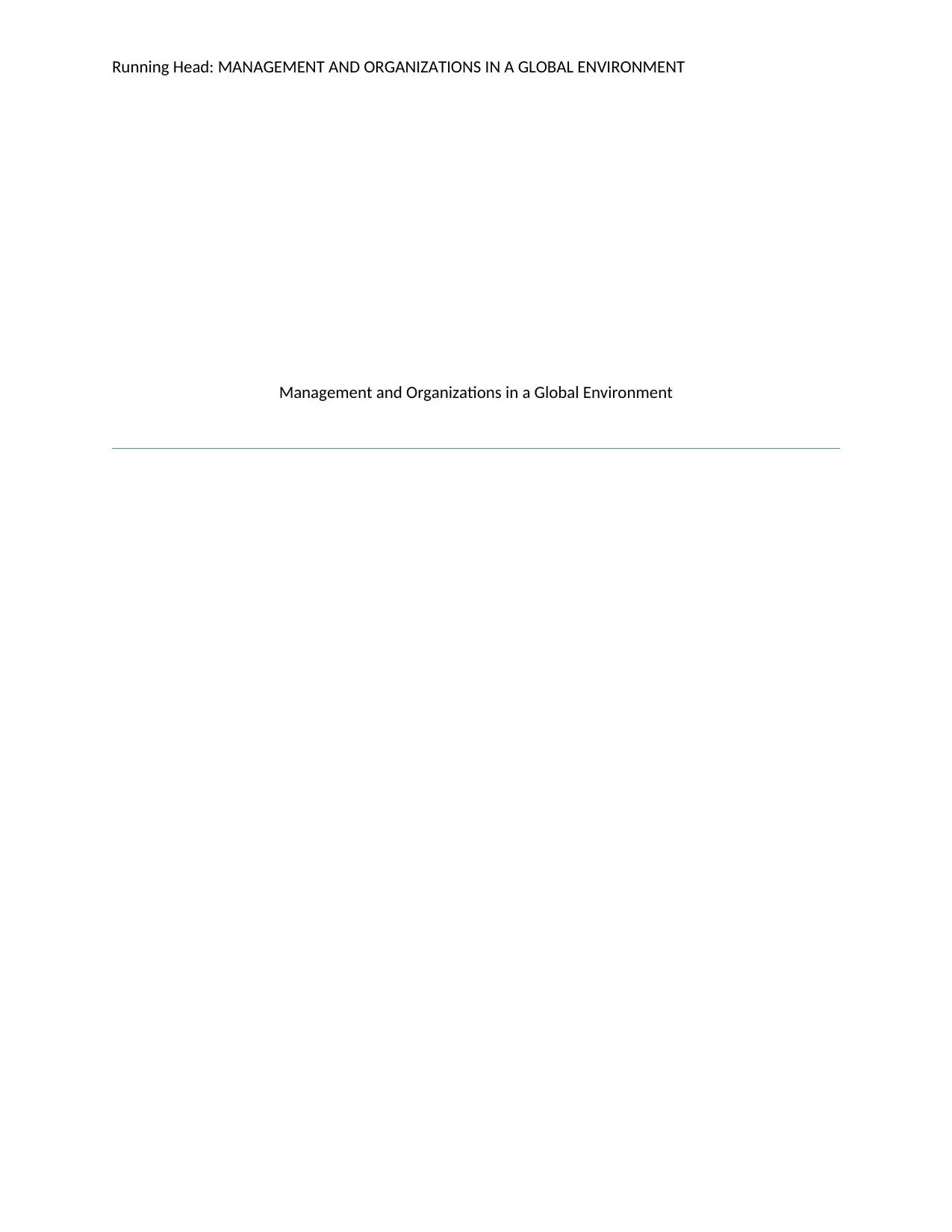
Running Head: MANAGEMENT AND ORGANIZATIONS IN A GLOBAL ENVIRONMENT
Management and Organizations in a Global Environment
Management and Organizations in a Global Environment
Paraphrase This Document
Need a fresh take? Get an instant paraphrase of this document with our AI Paraphraser
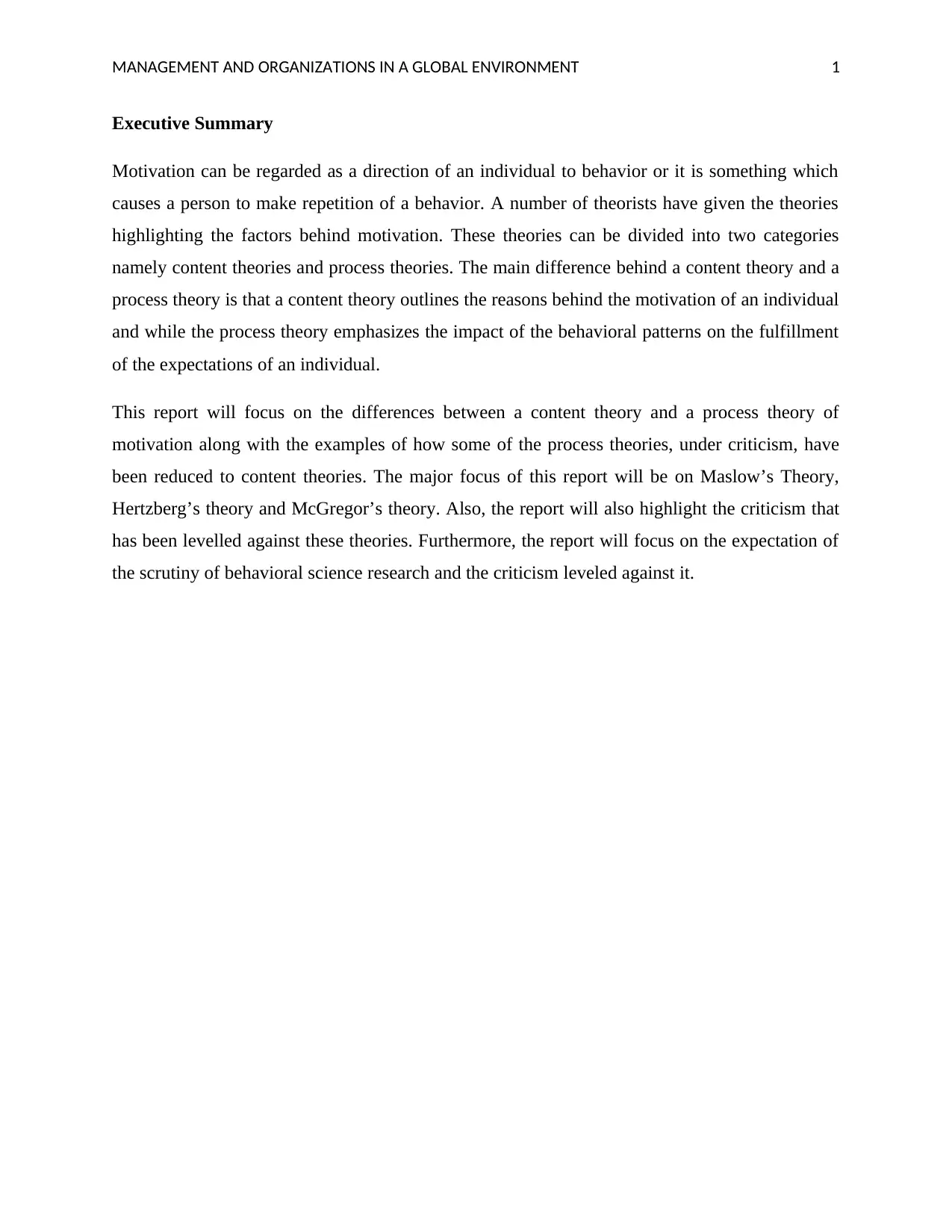
MANAGEMENT AND ORGANIZATIONS IN A GLOBAL ENVIRONMENT 1
Executive Summary
Motivation can be regarded as a direction of an individual to behavior or it is something which
causes a person to make repetition of a behavior. A number of theorists have given the theories
highlighting the factors behind motivation. These theories can be divided into two categories
namely content theories and process theories. The main difference behind a content theory and a
process theory is that a content theory outlines the reasons behind the motivation of an individual
and while the process theory emphasizes the impact of the behavioral patterns on the fulfillment
of the expectations of an individual.
This report will focus on the differences between a content theory and a process theory of
motivation along with the examples of how some of the process theories, under criticism, have
been reduced to content theories. The major focus of this report will be on Maslow’s Theory,
Hertzberg’s theory and McGregor’s theory. Also, the report will also highlight the criticism that
has been levelled against these theories. Furthermore, the report will focus on the expectation of
the scrutiny of behavioral science research and the criticism leveled against it.
Executive Summary
Motivation can be regarded as a direction of an individual to behavior or it is something which
causes a person to make repetition of a behavior. A number of theorists have given the theories
highlighting the factors behind motivation. These theories can be divided into two categories
namely content theories and process theories. The main difference behind a content theory and a
process theory is that a content theory outlines the reasons behind the motivation of an individual
and while the process theory emphasizes the impact of the behavioral patterns on the fulfillment
of the expectations of an individual.
This report will focus on the differences between a content theory and a process theory of
motivation along with the examples of how some of the process theories, under criticism, have
been reduced to content theories. The major focus of this report will be on Maslow’s Theory,
Hertzberg’s theory and McGregor’s theory. Also, the report will also highlight the criticism that
has been levelled against these theories. Furthermore, the report will focus on the expectation of
the scrutiny of behavioral science research and the criticism leveled against it.
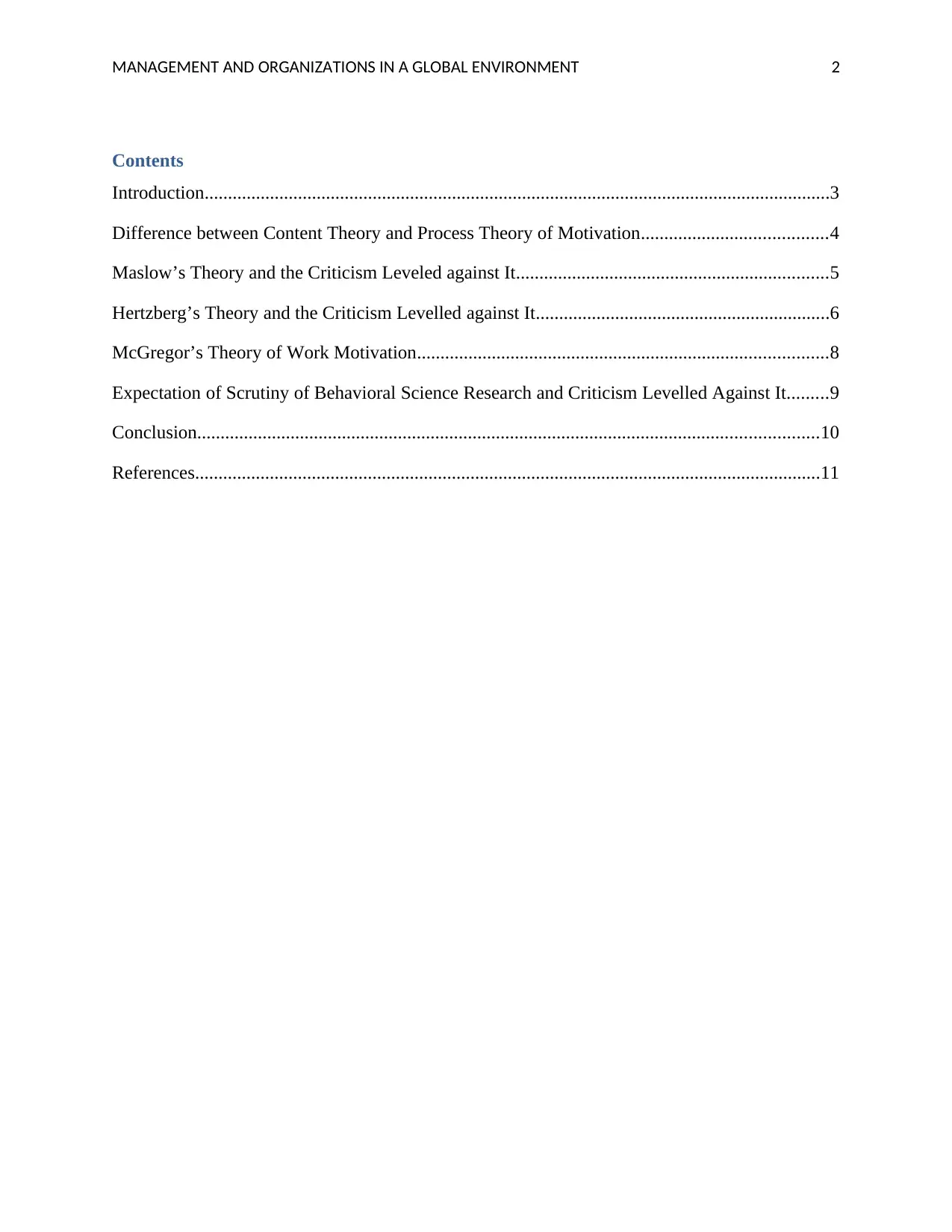
MANAGEMENT AND ORGANIZATIONS IN A GLOBAL ENVIRONMENT 2
Contents
Introduction......................................................................................................................................3
Difference between Content Theory and Process Theory of Motivation........................................4
Maslow’s Theory and the Criticism Leveled against It...................................................................5
Hertzberg’s Theory and the Criticism Levelled against It...............................................................6
McGregor’s Theory of Work Motivation........................................................................................8
Expectation of Scrutiny of Behavioral Science Research and Criticism Levelled Against It.........9
Conclusion.....................................................................................................................................10
References......................................................................................................................................11
Contents
Introduction......................................................................................................................................3
Difference between Content Theory and Process Theory of Motivation........................................4
Maslow’s Theory and the Criticism Leveled against It...................................................................5
Hertzberg’s Theory and the Criticism Levelled against It...............................................................6
McGregor’s Theory of Work Motivation........................................................................................8
Expectation of Scrutiny of Behavioral Science Research and Criticism Levelled Against It.........9
Conclusion.....................................................................................................................................10
References......................................................................................................................................11
⊘ This is a preview!⊘
Do you want full access?
Subscribe today to unlock all pages.

Trusted by 1+ million students worldwide
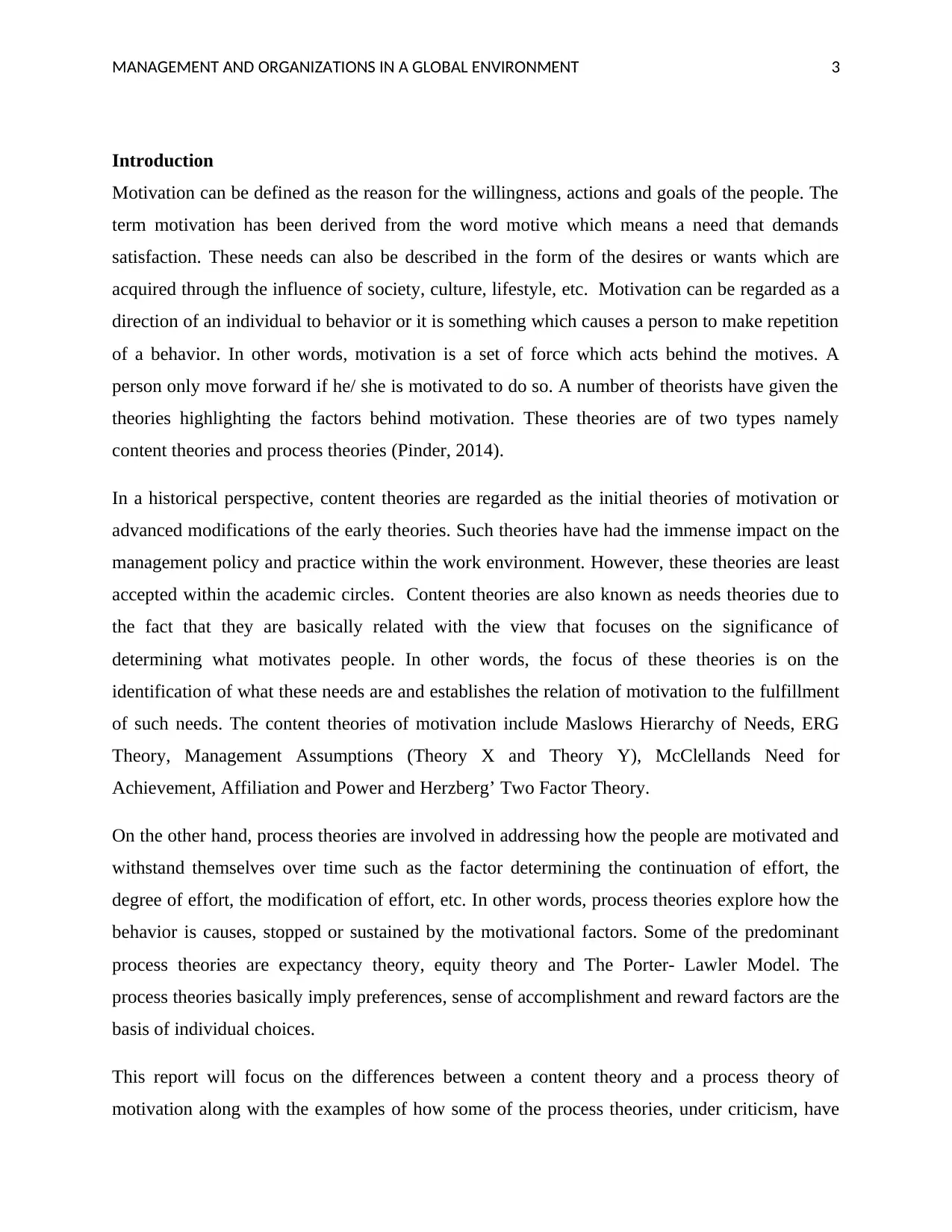
MANAGEMENT AND ORGANIZATIONS IN A GLOBAL ENVIRONMENT 3
Introduction
Motivation can be defined as the reason for the willingness, actions and goals of the people. The
term motivation has been derived from the word motive which means a need that demands
satisfaction. These needs can also be described in the form of the desires or wants which are
acquired through the influence of society, culture, lifestyle, etc. Motivation can be regarded as a
direction of an individual to behavior or it is something which causes a person to make repetition
of a behavior. In other words, motivation is a set of force which acts behind the motives. A
person only move forward if he/ she is motivated to do so. A number of theorists have given the
theories highlighting the factors behind motivation. These theories are of two types namely
content theories and process theories (Pinder, 2014).
In a historical perspective, content theories are regarded as the initial theories of motivation or
advanced modifications of the early theories. Such theories have had the immense impact on the
management policy and practice within the work environment. However, these theories are least
accepted within the academic circles. Content theories are also known as needs theories due to
the fact that they are basically related with the view that focuses on the significance of
determining what motivates people. In other words, the focus of these theories is on the
identification of what these needs are and establishes the relation of motivation to the fulfillment
of such needs. The content theories of motivation include Maslows Hierarchy of Needs, ERG
Theory, Management Assumptions (Theory X and Theory Y), McClellands Need for
Achievement, Affiliation and Power and Herzberg’ Two Factor Theory.
On the other hand, process theories are involved in addressing how the people are motivated and
withstand themselves over time such as the factor determining the continuation of effort, the
degree of effort, the modification of effort, etc. In other words, process theories explore how the
behavior is causes, stopped or sustained by the motivational factors. Some of the predominant
process theories are expectancy theory, equity theory and The Porter- Lawler Model. The
process theories basically imply preferences, sense of accomplishment and reward factors are the
basis of individual choices.
This report will focus on the differences between a content theory and a process theory of
motivation along with the examples of how some of the process theories, under criticism, have
Introduction
Motivation can be defined as the reason for the willingness, actions and goals of the people. The
term motivation has been derived from the word motive which means a need that demands
satisfaction. These needs can also be described in the form of the desires or wants which are
acquired through the influence of society, culture, lifestyle, etc. Motivation can be regarded as a
direction of an individual to behavior or it is something which causes a person to make repetition
of a behavior. In other words, motivation is a set of force which acts behind the motives. A
person only move forward if he/ she is motivated to do so. A number of theorists have given the
theories highlighting the factors behind motivation. These theories are of two types namely
content theories and process theories (Pinder, 2014).
In a historical perspective, content theories are regarded as the initial theories of motivation or
advanced modifications of the early theories. Such theories have had the immense impact on the
management policy and practice within the work environment. However, these theories are least
accepted within the academic circles. Content theories are also known as needs theories due to
the fact that they are basically related with the view that focuses on the significance of
determining what motivates people. In other words, the focus of these theories is on the
identification of what these needs are and establishes the relation of motivation to the fulfillment
of such needs. The content theories of motivation include Maslows Hierarchy of Needs, ERG
Theory, Management Assumptions (Theory X and Theory Y), McClellands Need for
Achievement, Affiliation and Power and Herzberg’ Two Factor Theory.
On the other hand, process theories are involved in addressing how the people are motivated and
withstand themselves over time such as the factor determining the continuation of effort, the
degree of effort, the modification of effort, etc. In other words, process theories explore how the
behavior is causes, stopped or sustained by the motivational factors. Some of the predominant
process theories are expectancy theory, equity theory and The Porter- Lawler Model. The
process theories basically imply preferences, sense of accomplishment and reward factors are the
basis of individual choices.
This report will focus on the differences between a content theory and a process theory of
motivation along with the examples of how some of the process theories, under criticism, have
Paraphrase This Document
Need a fresh take? Get an instant paraphrase of this document with our AI Paraphraser
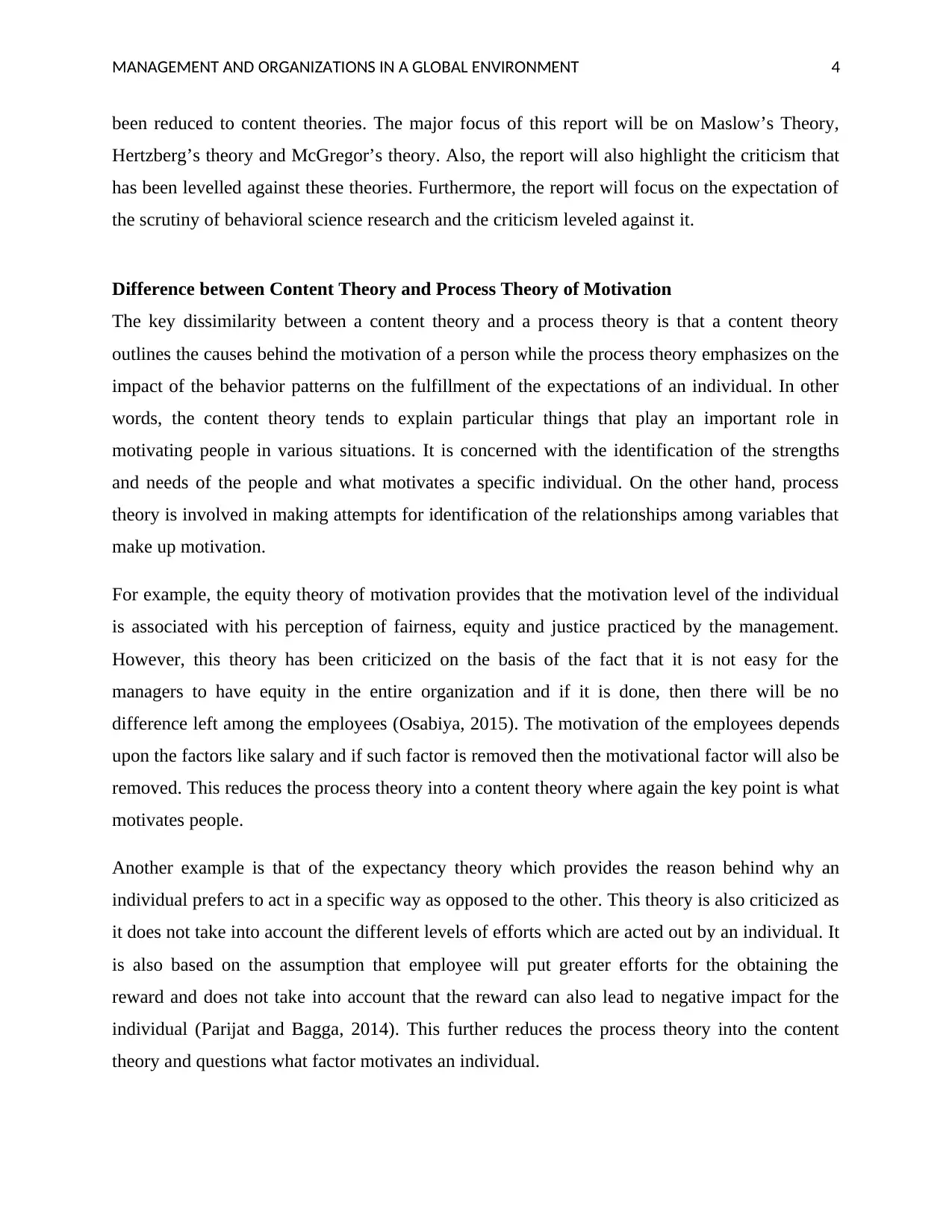
MANAGEMENT AND ORGANIZATIONS IN A GLOBAL ENVIRONMENT 4
been reduced to content theories. The major focus of this report will be on Maslow’s Theory,
Hertzberg’s theory and McGregor’s theory. Also, the report will also highlight the criticism that
has been levelled against these theories. Furthermore, the report will focus on the expectation of
the scrutiny of behavioral science research and the criticism leveled against it.
Difference between Content Theory and Process Theory of Motivation
The key dissimilarity between a content theory and a process theory is that a content theory
outlines the causes behind the motivation of a person while the process theory emphasizes on the
impact of the behavior patterns on the fulfillment of the expectations of an individual. In other
words, the content theory tends to explain particular things that play an important role in
motivating people in various situations. It is concerned with the identification of the strengths
and needs of the people and what motivates a specific individual. On the other hand, process
theory is involved in making attempts for identification of the relationships among variables that
make up motivation.
For example, the equity theory of motivation provides that the motivation level of the individual
is associated with his perception of fairness, equity and justice practiced by the management.
However, this theory has been criticized on the basis of the fact that it is not easy for the
managers to have equity in the entire organization and if it is done, then there will be no
difference left among the employees (Osabiya, 2015). The motivation of the employees depends
upon the factors like salary and if such factor is removed then the motivational factor will also be
removed. This reduces the process theory into a content theory where again the key point is what
motivates people.
Another example is that of the expectancy theory which provides the reason behind why an
individual prefers to act in a specific way as opposed to the other. This theory is also criticized as
it does not take into account the different levels of efforts which are acted out by an individual. It
is also based on the assumption that employee will put greater efforts for the obtaining the
reward and does not take into account that the reward can also lead to negative impact for the
individual (Parijat and Bagga, 2014). This further reduces the process theory into the content
theory and questions what factor motivates an individual.
been reduced to content theories. The major focus of this report will be on Maslow’s Theory,
Hertzberg’s theory and McGregor’s theory. Also, the report will also highlight the criticism that
has been levelled against these theories. Furthermore, the report will focus on the expectation of
the scrutiny of behavioral science research and the criticism leveled against it.
Difference between Content Theory and Process Theory of Motivation
The key dissimilarity between a content theory and a process theory is that a content theory
outlines the causes behind the motivation of a person while the process theory emphasizes on the
impact of the behavior patterns on the fulfillment of the expectations of an individual. In other
words, the content theory tends to explain particular things that play an important role in
motivating people in various situations. It is concerned with the identification of the strengths
and needs of the people and what motivates a specific individual. On the other hand, process
theory is involved in making attempts for identification of the relationships among variables that
make up motivation.
For example, the equity theory of motivation provides that the motivation level of the individual
is associated with his perception of fairness, equity and justice practiced by the management.
However, this theory has been criticized on the basis of the fact that it is not easy for the
managers to have equity in the entire organization and if it is done, then there will be no
difference left among the employees (Osabiya, 2015). The motivation of the employees depends
upon the factors like salary and if such factor is removed then the motivational factor will also be
removed. This reduces the process theory into a content theory where again the key point is what
motivates people.
Another example is that of the expectancy theory which provides the reason behind why an
individual prefers to act in a specific way as opposed to the other. This theory is also criticized as
it does not take into account the different levels of efforts which are acted out by an individual. It
is also based on the assumption that employee will put greater efforts for the obtaining the
reward and does not take into account that the reward can also lead to negative impact for the
individual (Parijat and Bagga, 2014). This further reduces the process theory into the content
theory and questions what factor motivates an individual.
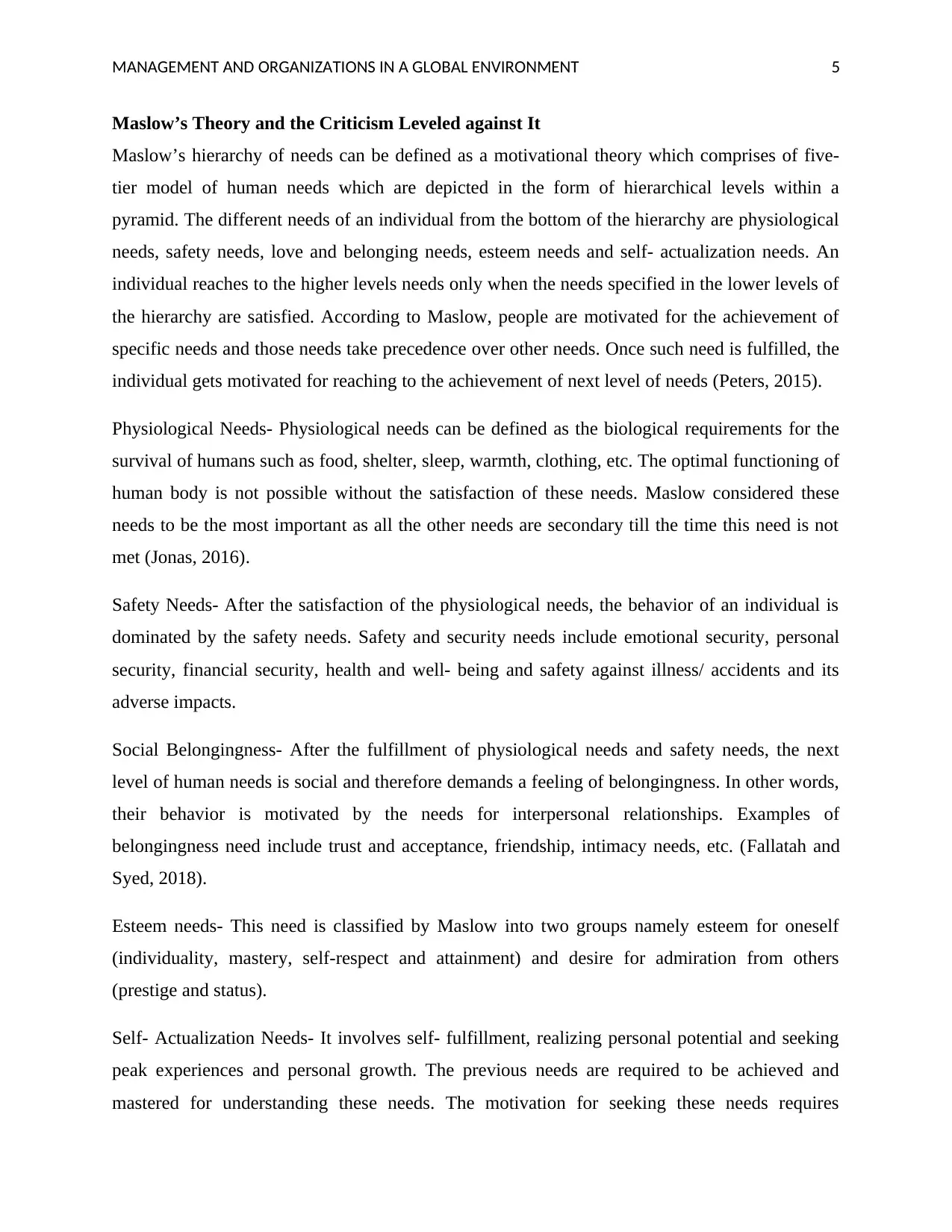
MANAGEMENT AND ORGANIZATIONS IN A GLOBAL ENVIRONMENT 5
Maslow’s Theory and the Criticism Leveled against It
Maslow’s hierarchy of needs can be defined as a motivational theory which comprises of five-
tier model of human needs which are depicted in the form of hierarchical levels within a
pyramid. The different needs of an individual from the bottom of the hierarchy are physiological
needs, safety needs, love and belonging needs, esteem needs and self- actualization needs. An
individual reaches to the higher levels needs only when the needs specified in the lower levels of
the hierarchy are satisfied. According to Maslow, people are motivated for the achievement of
specific needs and those needs take precedence over other needs. Once such need is fulfilled, the
individual gets motivated for reaching to the achievement of next level of needs (Peters, 2015).
Physiological Needs- Physiological needs can be defined as the biological requirements for the
survival of humans such as food, shelter, sleep, warmth, clothing, etc. The optimal functioning of
human body is not possible without the satisfaction of these needs. Maslow considered these
needs to be the most important as all the other needs are secondary till the time this need is not
met (Jonas, 2016).
Safety Needs- After the satisfaction of the physiological needs, the behavior of an individual is
dominated by the safety needs. Safety and security needs include emotional security, personal
security, financial security, health and well- being and safety against illness/ accidents and its
adverse impacts.
Social Belongingness- After the fulfillment of physiological needs and safety needs, the next
level of human needs is social and therefore demands a feeling of belongingness. In other words,
their behavior is motivated by the needs for interpersonal relationships. Examples of
belongingness need include trust and acceptance, friendship, intimacy needs, etc. (Fallatah and
Syed, 2018).
Esteem needs- This need is classified by Maslow into two groups namely esteem for oneself
(individuality, mastery, self-respect and attainment) and desire for admiration from others
(prestige and status).
Self- Actualization Needs- It involves self- fulfillment, realizing personal potential and seeking
peak experiences and personal growth. The previous needs are required to be achieved and
mastered for understanding these needs. The motivation for seeking these needs requires
Maslow’s Theory and the Criticism Leveled against It
Maslow’s hierarchy of needs can be defined as a motivational theory which comprises of five-
tier model of human needs which are depicted in the form of hierarchical levels within a
pyramid. The different needs of an individual from the bottom of the hierarchy are physiological
needs, safety needs, love and belonging needs, esteem needs and self- actualization needs. An
individual reaches to the higher levels needs only when the needs specified in the lower levels of
the hierarchy are satisfied. According to Maslow, people are motivated for the achievement of
specific needs and those needs take precedence over other needs. Once such need is fulfilled, the
individual gets motivated for reaching to the achievement of next level of needs (Peters, 2015).
Physiological Needs- Physiological needs can be defined as the biological requirements for the
survival of humans such as food, shelter, sleep, warmth, clothing, etc. The optimal functioning of
human body is not possible without the satisfaction of these needs. Maslow considered these
needs to be the most important as all the other needs are secondary till the time this need is not
met (Jonas, 2016).
Safety Needs- After the satisfaction of the physiological needs, the behavior of an individual is
dominated by the safety needs. Safety and security needs include emotional security, personal
security, financial security, health and well- being and safety against illness/ accidents and its
adverse impacts.
Social Belongingness- After the fulfillment of physiological needs and safety needs, the next
level of human needs is social and therefore demands a feeling of belongingness. In other words,
their behavior is motivated by the needs for interpersonal relationships. Examples of
belongingness need include trust and acceptance, friendship, intimacy needs, etc. (Fallatah and
Syed, 2018).
Esteem needs- This need is classified by Maslow into two groups namely esteem for oneself
(individuality, mastery, self-respect and attainment) and desire for admiration from others
(prestige and status).
Self- Actualization Needs- It involves self- fulfillment, realizing personal potential and seeking
peak experiences and personal growth. The previous needs are required to be achieved and
mastered for understanding these needs. The motivation for seeking these needs requires
⊘ This is a preview!⊘
Do you want full access?
Subscribe today to unlock all pages.

Trusted by 1+ million students worldwide
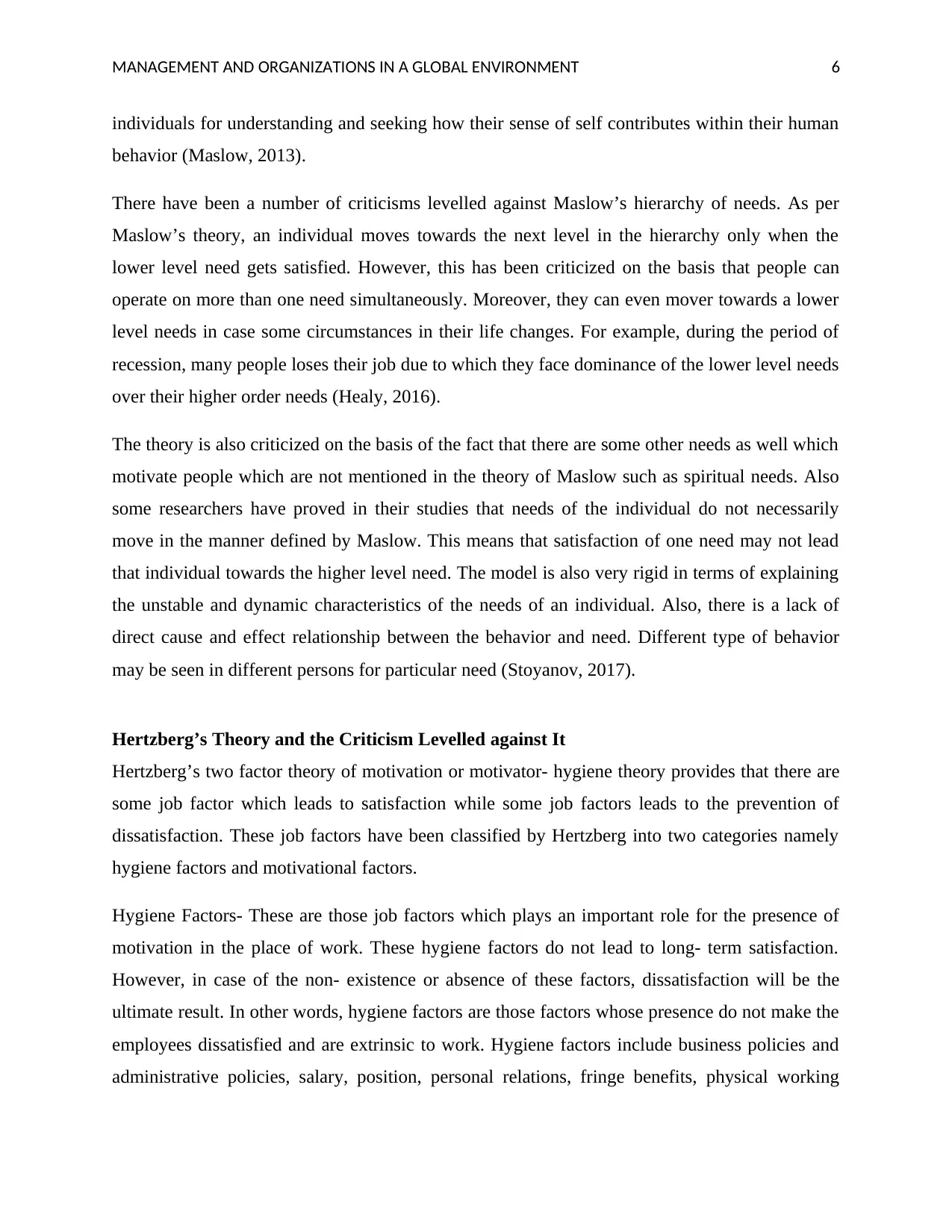
MANAGEMENT AND ORGANIZATIONS IN A GLOBAL ENVIRONMENT 6
individuals for understanding and seeking how their sense of self contributes within their human
behavior (Maslow, 2013).
There have been a number of criticisms levelled against Maslow’s hierarchy of needs. As per
Maslow’s theory, an individual moves towards the next level in the hierarchy only when the
lower level need gets satisfied. However, this has been criticized on the basis that people can
operate on more than one need simultaneously. Moreover, they can even mover towards a lower
level needs in case some circumstances in their life changes. For example, during the period of
recession, many people loses their job due to which they face dominance of the lower level needs
over their higher order needs (Healy, 2016).
The theory is also criticized on the basis of the fact that there are some other needs as well which
motivate people which are not mentioned in the theory of Maslow such as spiritual needs. Also
some researchers have proved in their studies that needs of the individual do not necessarily
move in the manner defined by Maslow. This means that satisfaction of one need may not lead
that individual towards the higher level need. The model is also very rigid in terms of explaining
the unstable and dynamic characteristics of the needs of an individual. Also, there is a lack of
direct cause and effect relationship between the behavior and need. Different type of behavior
may be seen in different persons for particular need (Stoyanov, 2017).
Hertzberg’s Theory and the Criticism Levelled against It
Hertzberg’s two factor theory of motivation or motivator- hygiene theory provides that there are
some job factor which leads to satisfaction while some job factors leads to the prevention of
dissatisfaction. These job factors have been classified by Hertzberg into two categories namely
hygiene factors and motivational factors.
Hygiene Factors- These are those job factors which plays an important role for the presence of
motivation in the place of work. These hygiene factors do not lead to long- term satisfaction.
However, in case of the non- existence or absence of these factors, dissatisfaction will be the
ultimate result. In other words, hygiene factors are those factors whose presence do not make the
employees dissatisfied and are extrinsic to work. Hygiene factors include business policies and
administrative policies, salary, position, personal relations, fringe benefits, physical working
individuals for understanding and seeking how their sense of self contributes within their human
behavior (Maslow, 2013).
There have been a number of criticisms levelled against Maslow’s hierarchy of needs. As per
Maslow’s theory, an individual moves towards the next level in the hierarchy only when the
lower level need gets satisfied. However, this has been criticized on the basis that people can
operate on more than one need simultaneously. Moreover, they can even mover towards a lower
level needs in case some circumstances in their life changes. For example, during the period of
recession, many people loses their job due to which they face dominance of the lower level needs
over their higher order needs (Healy, 2016).
The theory is also criticized on the basis of the fact that there are some other needs as well which
motivate people which are not mentioned in the theory of Maslow such as spiritual needs. Also
some researchers have proved in their studies that needs of the individual do not necessarily
move in the manner defined by Maslow. This means that satisfaction of one need may not lead
that individual towards the higher level need. The model is also very rigid in terms of explaining
the unstable and dynamic characteristics of the needs of an individual. Also, there is a lack of
direct cause and effect relationship between the behavior and need. Different type of behavior
may be seen in different persons for particular need (Stoyanov, 2017).
Hertzberg’s Theory and the Criticism Levelled against It
Hertzberg’s two factor theory of motivation or motivator- hygiene theory provides that there are
some job factor which leads to satisfaction while some job factors leads to the prevention of
dissatisfaction. These job factors have been classified by Hertzberg into two categories namely
hygiene factors and motivational factors.
Hygiene Factors- These are those job factors which plays an important role for the presence of
motivation in the place of work. These hygiene factors do not lead to long- term satisfaction.
However, in case of the non- existence or absence of these factors, dissatisfaction will be the
ultimate result. In other words, hygiene factors are those factors whose presence do not make the
employees dissatisfied and are extrinsic to work. Hygiene factors include business policies and
administrative policies, salary, position, personal relations, fringe benefits, physical working
Paraphrase This Document
Need a fresh take? Get an instant paraphrase of this document with our AI Paraphraser

MANAGEMENT AND ORGANIZATIONS IN A GLOBAL ENVIRONMENT 7
conditions, and job security. Such factors are also known as maintenance factors or dissatisfiers
as these factors perform the function of avoiding dissatisfaction (Hertzberg, 2017).
Motivational Factors- The hygiene factors cannot be described as motivators as per the two
factor theory. Motivational factors are those factors which results in positive satisfaction and are
inherent to work. These factors play an important role in motivating the employees to perform
better in their jobs. Motivational factors include responsibility, development and promotional
opportunities, appreciation, meaningfulness of work and sense of achievement. These factors are
also known as satisfiers as they are regarded to be intrinsically rewarding by the employees
(Alshmemri, Shahwan-Akl and Maude, 2017).
However, a number of authors have criticized the two factor theory presented by Hertzberg on
the basis of a number of points. Firstly, factors that have been described to be leading towards
satisfaction and dissatisfaction are not very much different from each other. It has been opposed
that responsibility, recognition and achievement are essential for both satisfaction and
dissatisfaction; on the other hand, dimensions such as salary, security and working conditions are
less significant. Secondly, Hertzberg’s two factor has been regarded as the over- simplification
of the actual relationship between dissatisfaction and motivation. Several studies have showed
that job satisfaction may result in a person by one factor and while the same factor can result in
job dissatisfaction for another. Thirdly, the differences between satisfiers and motivators are also
not completely accepted. The causes of satisfaction are generally attributed by people to their
own achievements. However, their dissatisfaction is attributed to obstacles faced by them as a
result of the policies of the company and superiors rather than their own deficiencies (Sanjeev
and Surya, 2016). The two factor theory of Hertzberg have also been criticized on the issue that
humans tend to look at those aspects of work which are liked by them and they project them onto
themselves at the time when the things are going well. Also, at bad times, a larger part is played
by the outside factors. Another criticism is due to the fact that this theory undertakes that job
satisfaction is equal to higher productivity of an individual. Moreover, there are a number of
reasons as a result of which this statement can be disagreed such as external factors which may
have an influence on the productivity. This has not been taken into account by Herzberg at the
time of researching for this theory.
conditions, and job security. Such factors are also known as maintenance factors or dissatisfiers
as these factors perform the function of avoiding dissatisfaction (Hertzberg, 2017).
Motivational Factors- The hygiene factors cannot be described as motivators as per the two
factor theory. Motivational factors are those factors which results in positive satisfaction and are
inherent to work. These factors play an important role in motivating the employees to perform
better in their jobs. Motivational factors include responsibility, development and promotional
opportunities, appreciation, meaningfulness of work and sense of achievement. These factors are
also known as satisfiers as they are regarded to be intrinsically rewarding by the employees
(Alshmemri, Shahwan-Akl and Maude, 2017).
However, a number of authors have criticized the two factor theory presented by Hertzberg on
the basis of a number of points. Firstly, factors that have been described to be leading towards
satisfaction and dissatisfaction are not very much different from each other. It has been opposed
that responsibility, recognition and achievement are essential for both satisfaction and
dissatisfaction; on the other hand, dimensions such as salary, security and working conditions are
less significant. Secondly, Hertzberg’s two factor has been regarded as the over- simplification
of the actual relationship between dissatisfaction and motivation. Several studies have showed
that job satisfaction may result in a person by one factor and while the same factor can result in
job dissatisfaction for another. Thirdly, the differences between satisfiers and motivators are also
not completely accepted. The causes of satisfaction are generally attributed by people to their
own achievements. However, their dissatisfaction is attributed to obstacles faced by them as a
result of the policies of the company and superiors rather than their own deficiencies (Sanjeev
and Surya, 2016). The two factor theory of Hertzberg have also been criticized on the issue that
humans tend to look at those aspects of work which are liked by them and they project them onto
themselves at the time when the things are going well. Also, at bad times, a larger part is played
by the outside factors. Another criticism is due to the fact that this theory undertakes that job
satisfaction is equal to higher productivity of an individual. Moreover, there are a number of
reasons as a result of which this statement can be disagreed such as external factors which may
have an influence on the productivity. This has not been taken into account by Herzberg at the
time of researching for this theory.
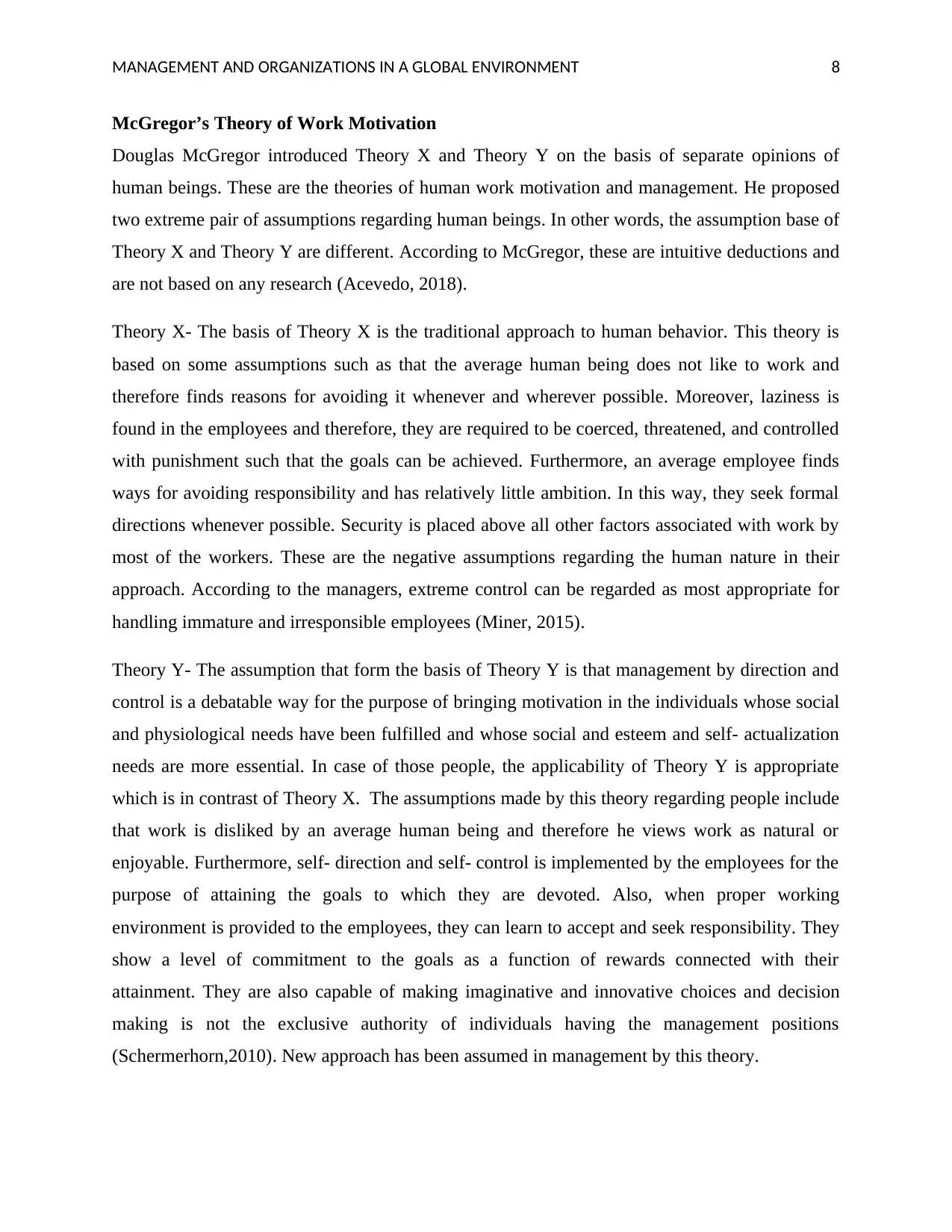
MANAGEMENT AND ORGANIZATIONS IN A GLOBAL ENVIRONMENT 8
McGregor’s Theory of Work Motivation
Douglas McGregor introduced Theory X and Theory Y on the basis of separate opinions of
human beings. These are the theories of human work motivation and management. He proposed
two extreme pair of assumptions regarding human beings. In other words, the assumption base of
Theory X and Theory Y are different. According to McGregor, these are intuitive deductions and
are not based on any research (Acevedo, 2018).
Theory X- The basis of Theory X is the traditional approach to human behavior. This theory is
based on some assumptions such as that the average human being does not like to work and
therefore finds reasons for avoiding it whenever and wherever possible. Moreover, laziness is
found in the employees and therefore, they are required to be coerced, threatened, and controlled
with punishment such that the goals can be achieved. Furthermore, an average employee finds
ways for avoiding responsibility and has relatively little ambition. In this way, they seek formal
directions whenever possible. Security is placed above all other factors associated with work by
most of the workers. These are the negative assumptions regarding the human nature in their
approach. According to the managers, extreme control can be regarded as most appropriate for
handling immature and irresponsible employees (Miner, 2015).
Theory Y- The assumption that form the basis of Theory Y is that management by direction and
control is a debatable way for the purpose of bringing motivation in the individuals whose social
and physiological needs have been fulfilled and whose social and esteem and self- actualization
needs are more essential. In case of those people, the applicability of Theory Y is appropriate
which is in contrast of Theory X. The assumptions made by this theory regarding people include
that work is disliked by an average human being and therefore he views work as natural or
enjoyable. Furthermore, self- direction and self- control is implemented by the employees for the
purpose of attaining the goals to which they are devoted. Also, when proper working
environment is provided to the employees, they can learn to accept and seek responsibility. They
show a level of commitment to the goals as a function of rewards connected with their
attainment. They are also capable of making imaginative and innovative choices and decision
making is not the exclusive authority of individuals having the management positions
(Schermerhorn,2010). New approach has been assumed in management by this theory.
McGregor’s Theory of Work Motivation
Douglas McGregor introduced Theory X and Theory Y on the basis of separate opinions of
human beings. These are the theories of human work motivation and management. He proposed
two extreme pair of assumptions regarding human beings. In other words, the assumption base of
Theory X and Theory Y are different. According to McGregor, these are intuitive deductions and
are not based on any research (Acevedo, 2018).
Theory X- The basis of Theory X is the traditional approach to human behavior. This theory is
based on some assumptions such as that the average human being does not like to work and
therefore finds reasons for avoiding it whenever and wherever possible. Moreover, laziness is
found in the employees and therefore, they are required to be coerced, threatened, and controlled
with punishment such that the goals can be achieved. Furthermore, an average employee finds
ways for avoiding responsibility and has relatively little ambition. In this way, they seek formal
directions whenever possible. Security is placed above all other factors associated with work by
most of the workers. These are the negative assumptions regarding the human nature in their
approach. According to the managers, extreme control can be regarded as most appropriate for
handling immature and irresponsible employees (Miner, 2015).
Theory Y- The assumption that form the basis of Theory Y is that management by direction and
control is a debatable way for the purpose of bringing motivation in the individuals whose social
and physiological needs have been fulfilled and whose social and esteem and self- actualization
needs are more essential. In case of those people, the applicability of Theory Y is appropriate
which is in contrast of Theory X. The assumptions made by this theory regarding people include
that work is disliked by an average human being and therefore he views work as natural or
enjoyable. Furthermore, self- direction and self- control is implemented by the employees for the
purpose of attaining the goals to which they are devoted. Also, when proper working
environment is provided to the employees, they can learn to accept and seek responsibility. They
show a level of commitment to the goals as a function of rewards connected with their
attainment. They are also capable of making imaginative and innovative choices and decision
making is not the exclusive authority of individuals having the management positions
(Schermerhorn,2010). New approach has been assumed in management by this theory.
⊘ This is a preview!⊘
Do you want full access?
Subscribe today to unlock all pages.

Trusted by 1+ million students worldwide
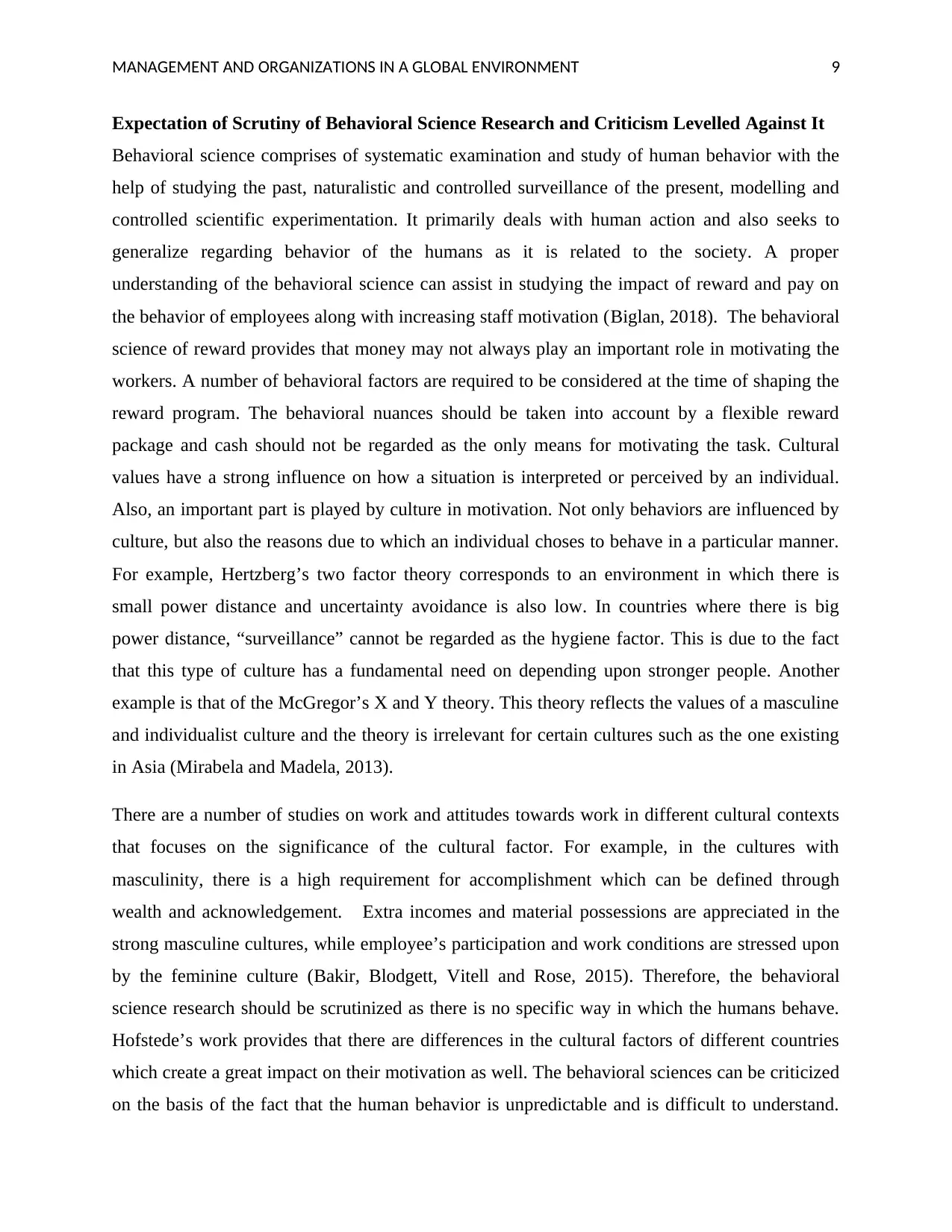
MANAGEMENT AND ORGANIZATIONS IN A GLOBAL ENVIRONMENT 9
Expectation of Scrutiny of Behavioral Science Research and Criticism Levelled Against It
Behavioral science comprises of systematic examination and study of human behavior with the
help of studying the past, naturalistic and controlled surveillance of the present, modelling and
controlled scientific experimentation. It primarily deals with human action and also seeks to
generalize regarding behavior of the humans as it is related to the society. A proper
understanding of the behavioral science can assist in studying the impact of reward and pay on
the behavior of employees along with increasing staff motivation (Biglan, 2018). The behavioral
science of reward provides that money may not always play an important role in motivating the
workers. A number of behavioral factors are required to be considered at the time of shaping the
reward program. The behavioral nuances should be taken into account by a flexible reward
package and cash should not be regarded as the only means for motivating the task. Cultural
values have a strong influence on how a situation is interpreted or perceived by an individual.
Also, an important part is played by culture in motivation. Not only behaviors are influenced by
culture, but also the reasons due to which an individual choses to behave in a particular manner.
For example, Hertzberg’s two factor theory corresponds to an environment in which there is
small power distance and uncertainty avoidance is also low. In countries where there is big
power distance, “surveillance” cannot be regarded as the hygiene factor. This is due to the fact
that this type of culture has a fundamental need on depending upon stronger people. Another
example is that of the McGregor’s X and Y theory. This theory reflects the values of a masculine
and individualist culture and the theory is irrelevant for certain cultures such as the one existing
in Asia (Mirabela and Madela, 2013).
There are a number of studies on work and attitudes towards work in different cultural contexts
that focuses on the significance of the cultural factor. For example, in the cultures with
masculinity, there is a high requirement for accomplishment which can be defined through
wealth and acknowledgement. Extra incomes and material possessions are appreciated in the
strong masculine cultures, while employee’s participation and work conditions are stressed upon
by the feminine culture (Bakir, Blodgett, Vitell and Rose, 2015). Therefore, the behavioral
science research should be scrutinized as there is no specific way in which the humans behave.
Hofstede’s work provides that there are differences in the cultural factors of different countries
which create a great impact on their motivation as well. The behavioral sciences can be criticized
on the basis of the fact that the human behavior is unpredictable and is difficult to understand.
Expectation of Scrutiny of Behavioral Science Research and Criticism Levelled Against It
Behavioral science comprises of systematic examination and study of human behavior with the
help of studying the past, naturalistic and controlled surveillance of the present, modelling and
controlled scientific experimentation. It primarily deals with human action and also seeks to
generalize regarding behavior of the humans as it is related to the society. A proper
understanding of the behavioral science can assist in studying the impact of reward and pay on
the behavior of employees along with increasing staff motivation (Biglan, 2018). The behavioral
science of reward provides that money may not always play an important role in motivating the
workers. A number of behavioral factors are required to be considered at the time of shaping the
reward program. The behavioral nuances should be taken into account by a flexible reward
package and cash should not be regarded as the only means for motivating the task. Cultural
values have a strong influence on how a situation is interpreted or perceived by an individual.
Also, an important part is played by culture in motivation. Not only behaviors are influenced by
culture, but also the reasons due to which an individual choses to behave in a particular manner.
For example, Hertzberg’s two factor theory corresponds to an environment in which there is
small power distance and uncertainty avoidance is also low. In countries where there is big
power distance, “surveillance” cannot be regarded as the hygiene factor. This is due to the fact
that this type of culture has a fundamental need on depending upon stronger people. Another
example is that of the McGregor’s X and Y theory. This theory reflects the values of a masculine
and individualist culture and the theory is irrelevant for certain cultures such as the one existing
in Asia (Mirabela and Madela, 2013).
There are a number of studies on work and attitudes towards work in different cultural contexts
that focuses on the significance of the cultural factor. For example, in the cultures with
masculinity, there is a high requirement for accomplishment which can be defined through
wealth and acknowledgement. Extra incomes and material possessions are appreciated in the
strong masculine cultures, while employee’s participation and work conditions are stressed upon
by the feminine culture (Bakir, Blodgett, Vitell and Rose, 2015). Therefore, the behavioral
science research should be scrutinized as there is no specific way in which the humans behave.
Hofstede’s work provides that there are differences in the cultural factors of different countries
which create a great impact on their motivation as well. The behavioral sciences can be criticized
on the basis of the fact that the human behavior is unpredictable and is difficult to understand.
Paraphrase This Document
Need a fresh take? Get an instant paraphrase of this document with our AI Paraphraser
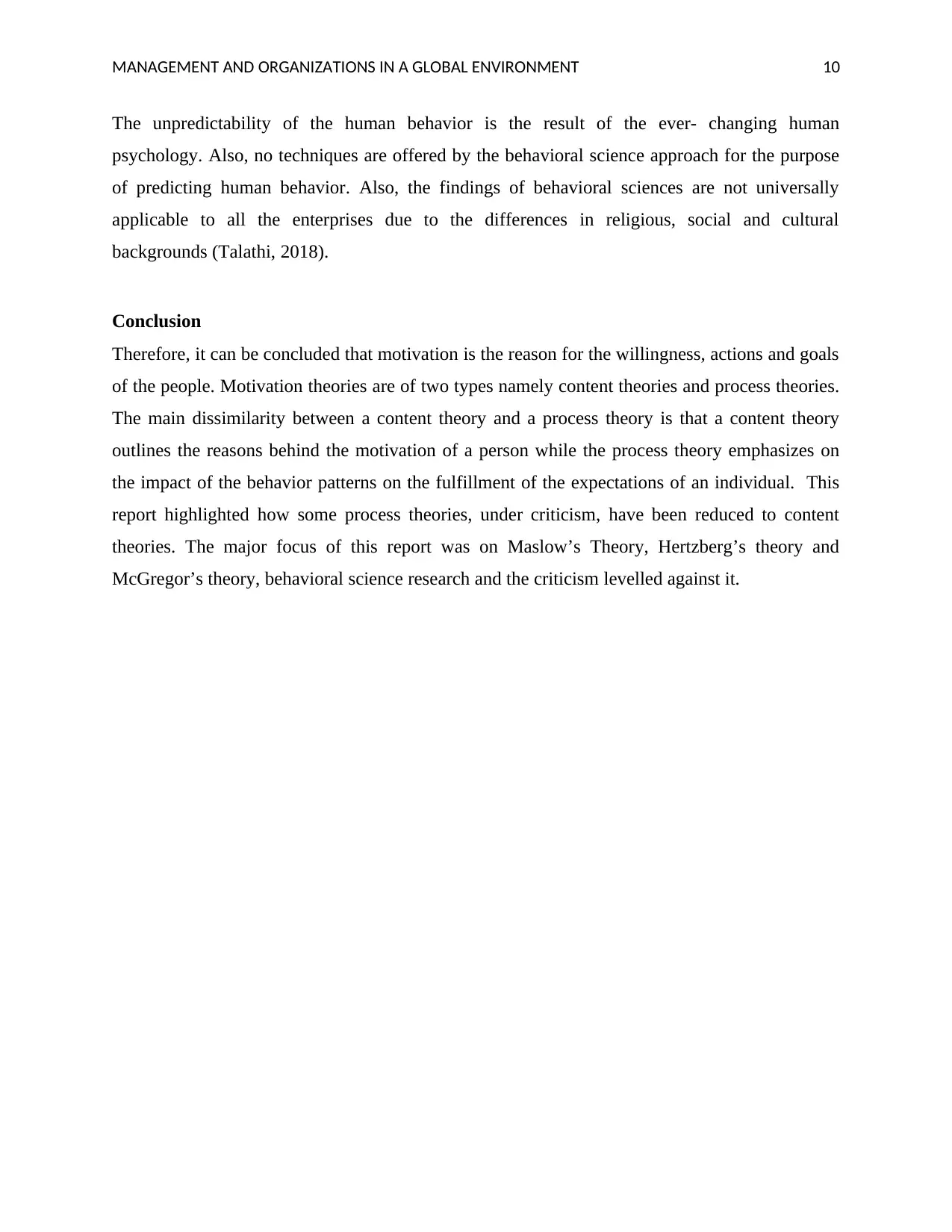
MANAGEMENT AND ORGANIZATIONS IN A GLOBAL ENVIRONMENT 10
The unpredictability of the human behavior is the result of the ever- changing human
psychology. Also, no techniques are offered by the behavioral science approach for the purpose
of predicting human behavior. Also, the findings of behavioral sciences are not universally
applicable to all the enterprises due to the differences in religious, social and cultural
backgrounds (Talathi, 2018).
Conclusion
Therefore, it can be concluded that motivation is the reason for the willingness, actions and goals
of the people. Motivation theories are of two types namely content theories and process theories.
The main dissimilarity between a content theory and a process theory is that a content theory
outlines the reasons behind the motivation of a person while the process theory emphasizes on
the impact of the behavior patterns on the fulfillment of the expectations of an individual. This
report highlighted how some process theories, under criticism, have been reduced to content
theories. The major focus of this report was on Maslow’s Theory, Hertzberg’s theory and
McGregor’s theory, behavioral science research and the criticism levelled against it.
The unpredictability of the human behavior is the result of the ever- changing human
psychology. Also, no techniques are offered by the behavioral science approach for the purpose
of predicting human behavior. Also, the findings of behavioral sciences are not universally
applicable to all the enterprises due to the differences in religious, social and cultural
backgrounds (Talathi, 2018).
Conclusion
Therefore, it can be concluded that motivation is the reason for the willingness, actions and goals
of the people. Motivation theories are of two types namely content theories and process theories.
The main dissimilarity between a content theory and a process theory is that a content theory
outlines the reasons behind the motivation of a person while the process theory emphasizes on
the impact of the behavior patterns on the fulfillment of the expectations of an individual. This
report highlighted how some process theories, under criticism, have been reduced to content
theories. The major focus of this report was on Maslow’s Theory, Hertzberg’s theory and
McGregor’s theory, behavioral science research and the criticism levelled against it.
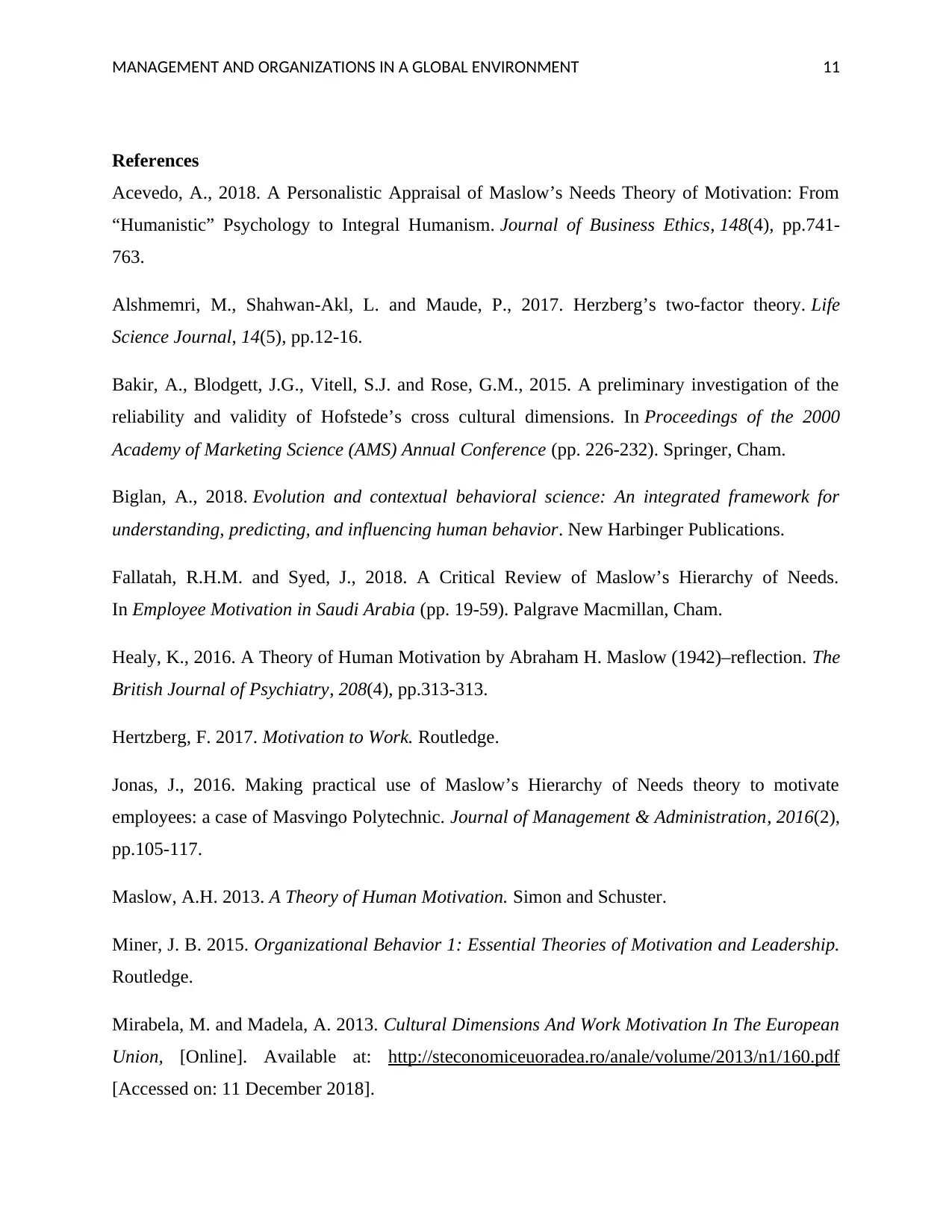
MANAGEMENT AND ORGANIZATIONS IN A GLOBAL ENVIRONMENT 11
References
Acevedo, A., 2018. A Personalistic Appraisal of Maslow’s Needs Theory of Motivation: From
“Humanistic” Psychology to Integral Humanism. Journal of Business Ethics, 148(4), pp.741-
763.
Alshmemri, M., Shahwan-Akl, L. and Maude, P., 2017. Herzberg’s two-factor theory. Life
Science Journal, 14(5), pp.12-16.
Bakir, A., Blodgett, J.G., Vitell, S.J. and Rose, G.M., 2015. A preliminary investigation of the
reliability and validity of Hofstede’s cross cultural dimensions. In Proceedings of the 2000
Academy of Marketing Science (AMS) Annual Conference (pp. 226-232). Springer, Cham.
Biglan, A., 2018. Evolution and contextual behavioral science: An integrated framework for
understanding, predicting, and influencing human behavior. New Harbinger Publications.
Fallatah, R.H.M. and Syed, J., 2018. A Critical Review of Maslow’s Hierarchy of Needs.
In Employee Motivation in Saudi Arabia (pp. 19-59). Palgrave Macmillan, Cham.
Healy, K., 2016. A Theory of Human Motivation by Abraham H. Maslow (1942)–reflection. The
British Journal of Psychiatry, 208(4), pp.313-313.
Hertzberg, F. 2017. Motivation to Work. Routledge.
Jonas, J., 2016. Making practical use of Maslow’s Hierarchy of Needs theory to motivate
employees: a case of Masvingo Polytechnic. Journal of Management & Administration, 2016(2),
pp.105-117.
Maslow, A.H. 2013. A Theory of Human Motivation. Simon and Schuster.
Miner, J. B. 2015. Organizational Behavior 1: Essential Theories of Motivation and Leadership.
Routledge.
Mirabela, M. and Madela, A. 2013. Cultural Dimensions And Work Motivation In The European
Union, [Online]. Available at: http://steconomiceuoradea.ro/anale/volume/2013/n1/160.pdf
[Accessed on: 11 December 2018].
References
Acevedo, A., 2018. A Personalistic Appraisal of Maslow’s Needs Theory of Motivation: From
“Humanistic” Psychology to Integral Humanism. Journal of Business Ethics, 148(4), pp.741-
763.
Alshmemri, M., Shahwan-Akl, L. and Maude, P., 2017. Herzberg’s two-factor theory. Life
Science Journal, 14(5), pp.12-16.
Bakir, A., Blodgett, J.G., Vitell, S.J. and Rose, G.M., 2015. A preliminary investigation of the
reliability and validity of Hofstede’s cross cultural dimensions. In Proceedings of the 2000
Academy of Marketing Science (AMS) Annual Conference (pp. 226-232). Springer, Cham.
Biglan, A., 2018. Evolution and contextual behavioral science: An integrated framework for
understanding, predicting, and influencing human behavior. New Harbinger Publications.
Fallatah, R.H.M. and Syed, J., 2018. A Critical Review of Maslow’s Hierarchy of Needs.
In Employee Motivation in Saudi Arabia (pp. 19-59). Palgrave Macmillan, Cham.
Healy, K., 2016. A Theory of Human Motivation by Abraham H. Maslow (1942)–reflection. The
British Journal of Psychiatry, 208(4), pp.313-313.
Hertzberg, F. 2017. Motivation to Work. Routledge.
Jonas, J., 2016. Making practical use of Maslow’s Hierarchy of Needs theory to motivate
employees: a case of Masvingo Polytechnic. Journal of Management & Administration, 2016(2),
pp.105-117.
Maslow, A.H. 2013. A Theory of Human Motivation. Simon and Schuster.
Miner, J. B. 2015. Organizational Behavior 1: Essential Theories of Motivation and Leadership.
Routledge.
Mirabela, M. and Madela, A. 2013. Cultural Dimensions And Work Motivation In The European
Union, [Online]. Available at: http://steconomiceuoradea.ro/anale/volume/2013/n1/160.pdf
[Accessed on: 11 December 2018].
⊘ This is a preview!⊘
Do you want full access?
Subscribe today to unlock all pages.

Trusted by 1+ million students worldwide
1 out of 13
Related Documents
Your All-in-One AI-Powered Toolkit for Academic Success.
+13062052269
info@desklib.com
Available 24*7 on WhatsApp / Email
![[object Object]](/_next/static/media/star-bottom.7253800d.svg)
Unlock your academic potential
Copyright © 2020–2025 A2Z Services. All Rights Reserved. Developed and managed by ZUCOL.



